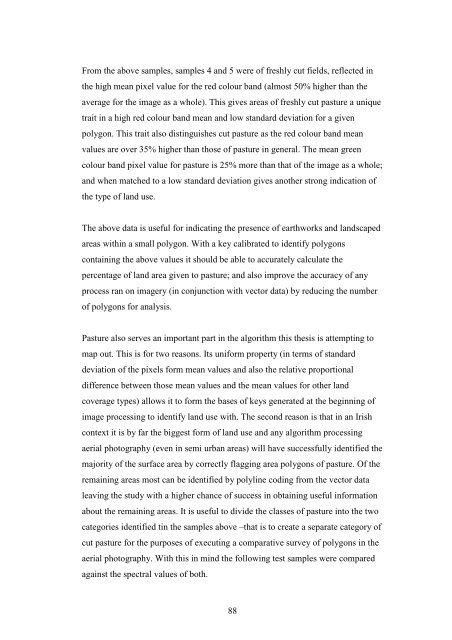Create successful ePaper yourself
Turn your PDF publications into a flip-book with our unique Google optimized e-Paper software.
From the above samples, samples 4 and 5 were of freshly cut fields, reflected in<br />
the high mean pixel value for the red colour band (almost 50% higher than the<br />
average for the image as a whole). This gives areas of freshly cut pasture a unique<br />
trait in a high red colour band mean and low standard deviation for a given<br />
polygon. This trait also distinguishes cut pasture as the red colour band mean<br />
values are over 35% higher than those of pasture in general. The mean green<br />
colour band pixel value for pasture is 25% more than that of the image as a whole;<br />
and when matched to a low standard deviation gives another strong indication of<br />
the type of land use.<br />
The above data is useful for indicating the presence of earthworks and landscaped<br />
areas within a small polygon. With a key calibrated to identify polygons<br />
containing the above values it should be able to accurately calculate the<br />
percentage of land area given to pasture; and also improve the accuracy of any<br />
process ran on imagery (in conjunction with vector data) by reducing the number<br />
of polygons for analysis.<br />
Pasture also serves an important part in the algorithm this thesis is attempting to<br />
map out. This is for two reasons. Its uniform property (in terms of standard<br />
deviation of the pixels form mean values and also the relative proportional<br />
difference between those mean values and the mean values for other land<br />
coverage types) allows it to form the bases of keys generated at the beginning of<br />
image processing to identify land use with. The second reason is that in an Irish<br />
context it is by far the biggest form of land use and any algorithm processing<br />
aerial photography (even in semi urban areas) will have successfully identified the<br />
majority of the surface area by correctly flagging area polygons of pasture. Of the<br />
remaining areas most can be identified by polyline coding from the vector data<br />
leaving the study with a higher chance of success in obtaining useful information<br />
about the remaining areas. It is useful to divide the classes of pasture into the two<br />
categories identified tin the samples above –that is to create a separate category of<br />
cut pasture for the purposes of executing a comparative survey of polygons in the<br />
aerial photography. With this in mind the following test samples were compared<br />
against the spectral values of both.<br />
88
















